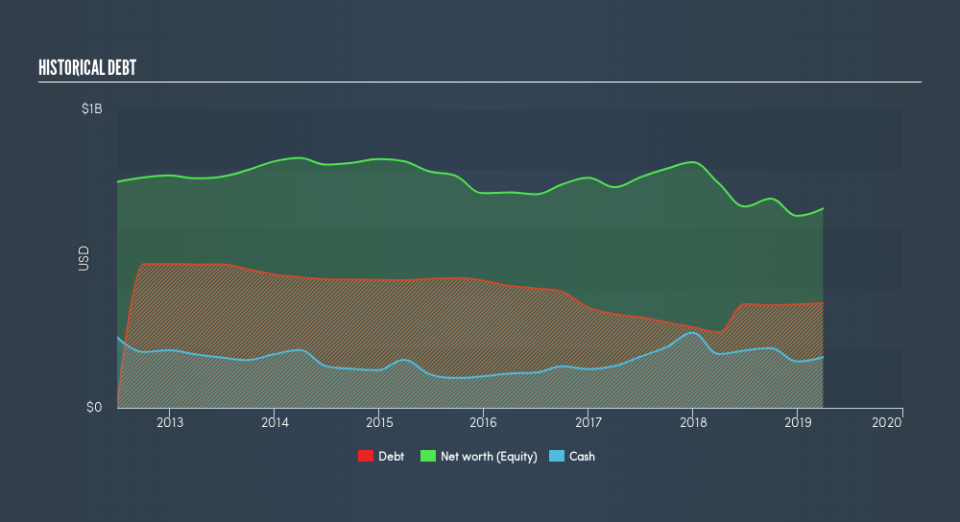Is Haemonetics Corporation (NYSE:HAE) A Financially Sound Company?

Want to participate in a short research study? Help shape the future of investing tools and you could win a $250 gift card!
Stocks with market capitalization between $2B and $10B, such as Haemonetics Corporation (NYSE:HAE) with a size of US$5.8b, do not attract as much attention from the investing community as do the small-caps and large-caps. However, history shows that overlooked mid-cap companies have performed better on a risk-adjusted manner than the smaller and larger segment of the market. Today we will look at HAE’s financial liquidity and debt levels, which are strong indicators for whether the company can weather economic downturns or fund strategic acquisitions for future growth. Note that this commentary is very high-level and solely focused on financial health, so I suggest you dig deeper yourself into HAE here.
View our latest analysis for Haemonetics
Does HAE Produce Much Cash Relative To Its Debt?
Over the past year, HAE has ramped up its debt from US$254m to US$350m , which accounts for long term debt. With this increase in debt, HAE currently has US$169m remaining in cash and short-term investments , ready to be used for running the business. Moreover, HAE has produced US$159m in operating cash flow in the last twelve months, leading to an operating cash to total debt ratio of 45%, indicating that HAE’s current level of operating cash is high enough to cover debt.
Does HAE’s liquid assets cover its short-term commitments?
Looking at HAE’s US$236m in current liabilities, it seems that the business has been able to meet these commitments with a current assets level of US$576m, leading to a 2.44x current account ratio. The current ratio is the number you get when you divide current assets by current liabilities. For Medical Equipment companies, this ratio is within a sensible range as there's enough of a cash buffer without holding too much capital in low return investments.
Can HAE service its debt comfortably?
HAE is a relatively highly levered company with a debt-to-equity of 52%. This is not uncommon for a mid-cap company given that debt tends to be lower-cost and at times, more accessible. No matter how high the company’s debt, if it can easily cover the interest payments, it’s considered to be efficient with its use of excess leverage. A company generating earnings after interest and tax at least three times its net interest payments is considered financially sound. In HAE's case, the ratio of 9.29x suggests that interest is appropriately covered, which means that lenders may be inclined to lend more money to the company, as it is seen as safe in terms of payback.
Next Steps:
Although HAE’s debt level is towards the higher end of the spectrum, its cash flow coverage seems adequate to meet obligations which means its debt is being efficiently utilised. This may mean this is an optimal capital structure for the business, given that it is also meeting its short-term commitment. This is only a rough assessment of financial health, and I'm sure HAE has company-specific issues impacting its capital structure decisions. You should continue to research Haemonetics to get a better picture of the mid-cap by looking at:
Future Outlook: What are well-informed industry analysts predicting for HAE’s future growth? Take a look at our free research report of analyst consensus for HAE’s outlook.
Valuation: What is HAE worth today? Is the stock undervalued, even when its growth outlook is factored into its intrinsic value? The intrinsic value infographic in our free research report helps visualize whether HAE is currently mispriced by the market.
Other High-Performing Stocks: Are there other stocks that provide better prospects with proven track records? Explore our free list of these great stocks here.
We aim to bring you long-term focused research analysis driven by fundamental data. Note that our analysis may not factor in the latest price-sensitive company announcements or qualitative material.
If you spot an error that warrants correction, please contact the editor at editorial-team@simplywallst.com. This article by Simply Wall St is general in nature. It does not constitute a recommendation to buy or sell any stock, and does not take account of your objectives, or your financial situation. Simply Wall St has no position in the stocks mentioned. Thank you for reading.

